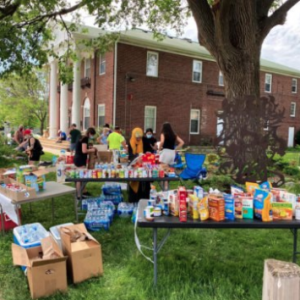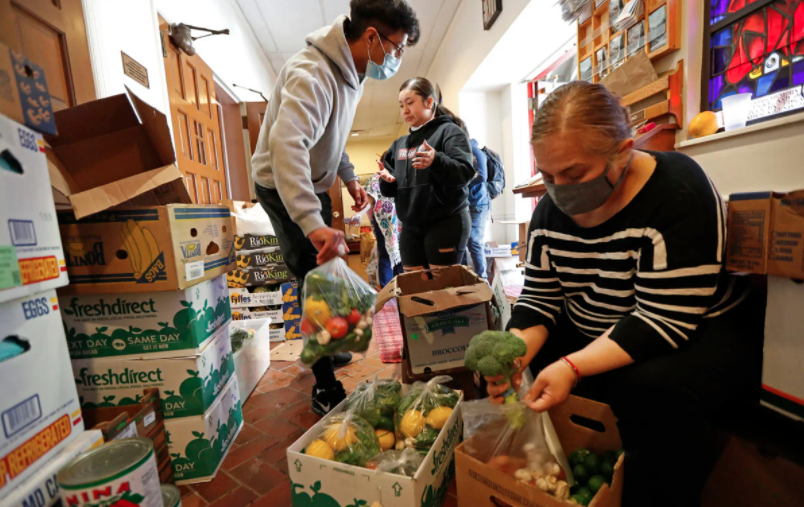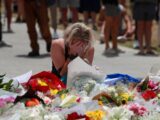(RNS) — Groceries. Prepared meals. Face masks. Prayer requests. Housing. Rent assistance. Mental health care. Spiritual guidance. Career advice. Transportation.
The requests for help keep coming at Forefront Church, at all hours of the day and night, and Zanifa Franck keeps responding.
You may unsubscribe from any of our newsletters at any time.
“If you need aid and we have it, we’re going to give it to you,” says Franck, direct deacon for the Brooklyn church’s active 12-member care team, launched at the pandemic’s onset in an effort to live out Forefront’s anti-racist mission. “There’s no parameters or criteria or rules for how you get aid.”
Like many volunteers involved in the current resurgence of mutual aid projects, Franck says her efforts are driven both by the understanding that existing welfare systems are broken — and that it’s her duty as a believer to step in.
“The foundation of being a radical Christ follower is truly believing that every human, whether they’re Muslim or Buddhist or anyone, deserves access to power and access to basic necessities of life,” Franck told Religion News Service. “For whatever reason, society has not allowed you to have access. So if I have it, I need to share it.”
Through mutual aid, community members take up the responsibility for caring for each other. Members of mutual aid networks look to one another to share resources and fulfill needs, rather than relying on intervention from external institutions such as governments or nonprofits.
Activists say the pandemic has exposed the failures and inequities of these institutions.
More on Broadview: Practicing community care in isolation
Over the past four months, as state unemployment sites have crashed, federal stimulus checks have been delayed and food banks stretched thin, mutual aid and direct action have emerged as popular vehicles for neighbours to support one another. Initiatives have sprung up in neighbourhoods across America, as a map by Town Hall Project illustrates, focused both on coronavirus relief and on supporting Black Lives Matter protests.
These community-led projects are organizing infrastructures to link those with food, masks, funds and other resources to those without. From Orlando’s Episcopal Church of St. John the Baptist to The Table D.C. church network to Chicago’s Anshe Emet synagogue, faith groups across different traditions are getting involved.
A block away from where George Floyd was killed by a police officer, dozens of volunteers have for weeks gathered at the Minneapolis Baha’i Center to support locals in need. It began with handing out water bottles to protesters and rapidly spiralled into a full-on donation intake and distribution centre for first aid supplies, canned food, hygiene products, diapers and more.
“Next thing you know, the centre is filled with supplies and we’re setting up tables out front,” volunteer Rishad Dalal said. “We set up a system for intakes, we have runners and organizers. We’re just trying to fulfill the needs of our neighbourhood.”
Activist Asma Mohammed Nizami has not been able to leave her home just outside Minneapolis because of immunocompromised family members. But that hasn’t stopped her from staying up until 7 a.m. every day for weeks, coordinating mutual aid efforts with the Twin Cities Mutual Aid Project.
Through her Twitter account, group chats and phone calls, Nizami is providing local volunteers and protesters updates by the minute on which donation sites are open, what their needs are, where rides are available, where medics are needed and the street-by-street movement of the National Guard. Through her organization Reviving Sisterhood, she’s also been paying for hotel rooms for families who recently lost their homes.
She points to a tradition of the Prophet Muhammad, who compared his followers to a human body. In their mutual compassion, he described, “when any limb aches, the whole body reacts with sleeplessness and fever.”
The premise of mutual aid is rooted in such solidarity, organizers explain, as opposed to charity.
“With charity, you can be very removed from the idea of what you’re fighting toward,” said Boston-based organizer Queen-Cheyenne Wade. “With mutual aid, you get around these bureaucratic systems and are directly giving those resources to the community, to the people.”
CURRENT NEEDS AT POWDERHORN:
-Camping gear (sleeping bags/pads, tents, tarps, pillows, blankets)
-LED lanterns/flashlights
-Cigarettes
-Sani wipes
-Chapstick
-Hand warmers
-Folding tables/chairs
-Hoodies, shirts, boxers
-Small padlocks
-Portable or wall chargers
-Big plastic bins pic.twitter.com/6aEgXd4TYa— Asma Nizami (@asmaresists) June 13, 2020
A co-founder of the Greater Boston Marxist Association and a lead organizer in the Muslim women-led Boston Mutual Aid Fund, Wade has been coordinating ride sharing, food, water and personal protective equipment for vulnerable communities in the Boston area as well as local anti-racism protesters.
As more people get invested in today’s anti-racist mutual aid efforts, they’re tapping into a long history of mutual aid in Black liberation movements, Wade said.
“A lot of Black Americans have this saying about making something out of nothing,” she said. “We’re taking our faith in our community, in ourselves and what is given to us — which is nothing — and building that into something greater.”
The country’s first independent Black churches, which served as a rare refuge for Black people to worship away from white control, emerged out of the Free African Society, a faith-based mutual aid network formed in 1787 to support widowed, orphaned, sick and unemployed Black people. In the ’60s and ’70s, the Black Panthers fed and educated kids and provided medical care for free. The Nation of Islam, too, promoted Black economic self-sufficiency with food co-op programs, collective farming projects and businesses.
“We’re taking our faith in our community, in ourselves and what is given to us — which is nothing — and building that into something greater.”
“We’ve always had to figure out how to take care of our community, to take care of our neighbourhoods and take care of our seniors, even when the economy is booming,” the Rev. Traci Blackmon, associate general minister of justice at the United Church of Christ, told NPR this month. “So in some ways, we’re ahead of the game with this, because we know how to survive with less, because we’ve always had to survive.”
Black communities have used cooperative economic activities as a tool for survival since Africans were first brought to America. As Jessica Gordon Nembhard’s “Collective Courage” explains, such solidarity practices included enslaved people pooling funds to buy one another’s freedom when a slave owner was willing to sell; and the formation of co-ops for Black farms, grocery stores, gas stations, schools, housing and more throughout the last century.
In the late 19th and early 20th centuries, more Americans belonged to fraternal societies than any other kind of voluntary association besides churches, historian David Beito explained in his 2000 book “From Mutual Aid to the Welfare State.” Men and women from working-class, African American and various immigrant backgrounds formed lodges, fraternal societies, social welfare organizations and extensive mutual aid networks, making health care, insurance and other needs accessible to all.
Assistance from public and private institutions was not only insufficient but also stigmatized. Fraternal aid instead “rested on an ethical principle of reciprocity,” Beito wrote. “Donors and recipients often came from the same, or nearly the same, walks of life; today’s recipient could be tomorrow’s donor, and vice versa.”
Some of these historic faith-based efforts are still going. Take the Mutual Aid Agency, born in the late 1800s out of the Anabaptist tradition as “an alternative to worldly insurance,” or Thrivent Financial, the result of a merger between the Aid Association for Lutherans and Lutheran Brotherhood fraternal benefit societies.
In the years since the Depression, historians say, government welfare, insurance companies, credit unions, nonprofit organizations and religious charities have taken over these roles, and mutual aid has largely fallen out of vogue.

Now again, as volunteers have done after countless economic crises, natural disasters and other upheaval, community members are building new grassroots networks to support their communities.
“With COVID-19 and the added separation that we are feeling from people, it’s definitely forcing people to think of different ways that they can show solidarity and engage in being an accomplice in these struggles,” Wade said.
A letter signed by close to 100 faith leaders across Washington, D.C., urging local officials to reallocate police funds into public safety and health initiatives, pointed to current mutual aid efforts as a model for a district without policing.
“We want to see a city where neighbours look after each other and where congregations and communities work together to provide for each other and keep each other safe,” the leaders wrote. “We have seen the seeds of this time of radical love of neighbour in mutual aid networks that have sprung up all across the city.”
Through mutual aid, activists argued, communities can bring to life a better world.
For Wade, that means a striving toward a world free of artificial hierarchies.
“Mutual aid can help us envision a world of unity, a world of inequality, a world of balance,” she said. “Class lines and racial barriers and all these constructs have no place in this divine unity that we’re striving for.”
This story was supported by the Solutions Journalism Network, a nonprofit organization dedicated to rigorous and compelling reporting about responses to social problems.














